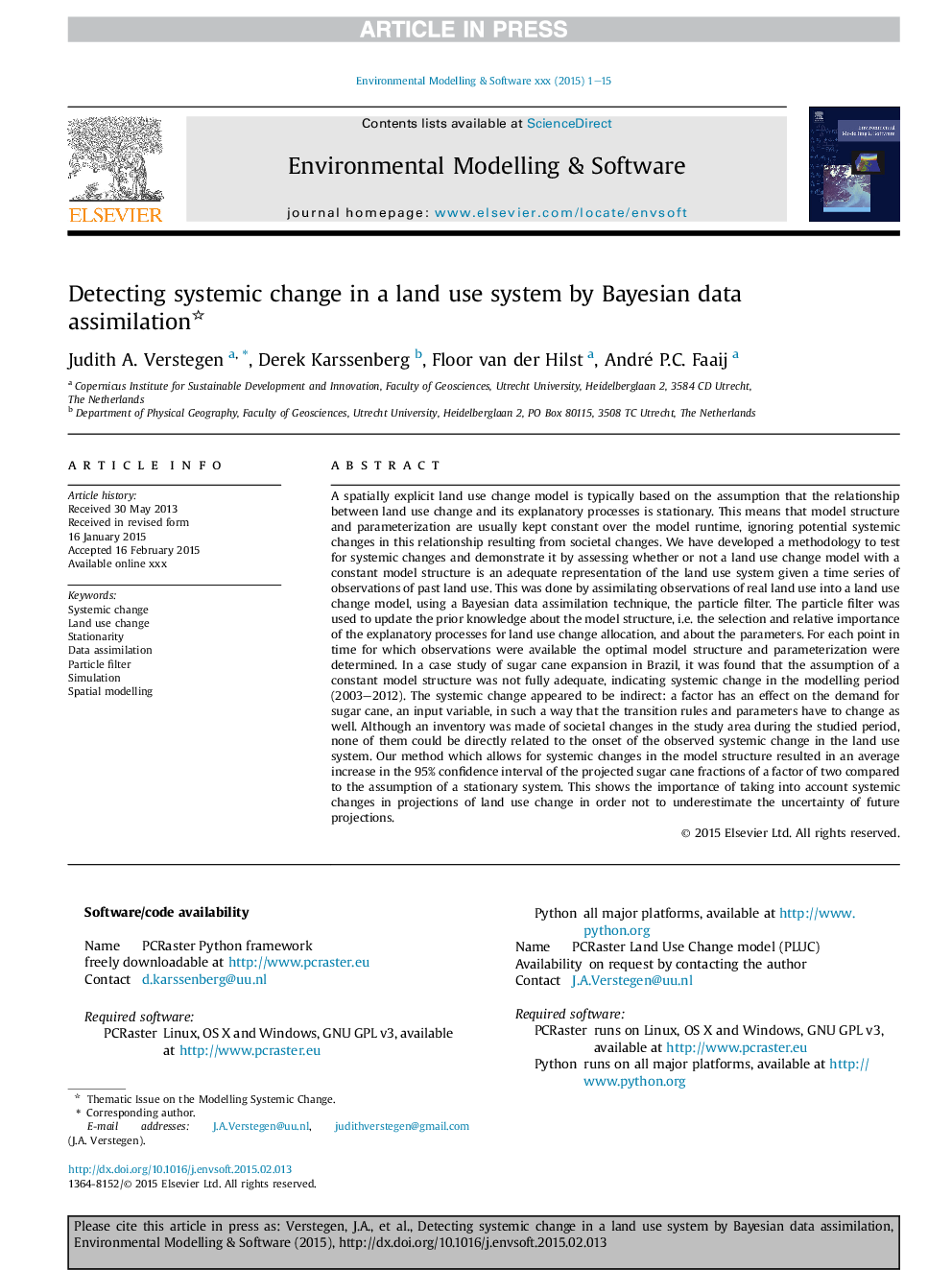| کد مقاله | کد نشریه | سال انتشار | مقاله انگلیسی | نسخه تمام متن |
|---|---|---|---|---|
| 6962705 | 1452275 | 2016 | 15 صفحه PDF | دانلود رایگان |
عنوان انگلیسی مقاله ISI
Detecting systemic change in a land use system by Bayesian data assimilation
ترجمه فارسی عنوان
تشخیص تغییر سیستمیک در یک سیستم استفاده از زمین با استفاده از داده های بیزی
دانلود مقاله + سفارش ترجمه
دانلود مقاله ISI انگلیسی
رایگان برای ایرانیان
کلمات کلیدی
تغییر سیستمیک، تغییر کاربری زمین، استنادی، تسریع داده ها، فیلتر ذرات، شبیه سازی، مدلسازی فضایی،
ترجمه چکیده
مدل تغییر اساسی استفاده از اشکال فضایی معمولا بر اساس این فرض است که رابطه بین تغییر کاربری زمین و فرآیندهای توضیحی آن ثابت است. این به این معنی است که ساختار مدل و پارامترها معمولا در طول زمان اجرا مدل ثابت باقی می مانند، نادیده گرفتن تغییرات سیستماتیک بالقوه در این رابطه ناشی از تغییرات اجتماعی است. ما یک روش برای تست تغییرات سیستمیک ایجاد کرده ایم و آن را با ارزیابی اینکه آیا تغییر مدل استفاده از زمین با ساختار مدل ثابت، نشان دهنده کافی از سیستم استفاده از زمین با توجه به مجموعه ای از مشاهدات از استفاده از زمین گذشته است یا خیر. این امر با به دست آوردن مشاهدات استفاده واقعی از زمین به یک مدل تغییر کاربری زمین، با استفاده از روش جذب داده های بیزی، فیلتر ذرات انجام شد. فیلتر ذرات برای به روز رسانی اطلاعات پیشین در مورد ساختار مدل، یعنی انتخاب و اهمیت نسبی فرایندهای توضیحی برای تخصیص تغییر کاربری زمین و پارامترها استفاده شده است. برای هر نقطه زمانی که مشاهدات در دسترس بود، ساختار مدل مطلوب و پارامتره تعیین شد. در یک مطالعه موردی از گسترش قارچ در برزیل، دریافت شد که فرض ساختار مدل ثابت به طور کامل کافی نیست، نشان دهنده تغییر سیستمیک در دوره مدل سازی (2003-2012). تغییر سیستمیک به طور غیرمستقیم ظاهر می شود: یک عامل بر تقاضا برای قند نان، یک متغیر ورودی تاثیر می گذارد، به این ترتیب قوانین و پارامترهای انتقال نیز باید تغییر کند. اگر چه در طول دوره مورد مطالعه از تغییرات اجتماعی در منطقه مورد مطالعه ساخته شد، هیچ یک از آنها به طور مستقیم به تغییر تغییر سیستمیک مشاهده شده در سیستم استفاده از زمین منجر نشد. روش ما که اجازه می دهد تا تغییرات سیستمیک در ساختار مدل موجب افزایش متوسط در فاصله اطمینان 95٪ از تخمین می شود تقریبا دو برابر نسبت به فرض یک سیستم ثابت. این نشان دهنده اهمیت توجه به تغییرات سیستماتیک در پیش بینی های تغییر کاربری زمین است تا عدم اطمینان بودن پیش بینی های آینده را بدست نیاورد.
موضوعات مرتبط
مهندسی و علوم پایه
مهندسی کامپیوتر
نرم افزار
چکیده انگلیسی
A spatially explicit land use change model is typically based on the assumption that the relationship between land use change and its explanatory processes is stationary. This means that model structure and parameterization are usually kept constant over the model runtime, ignoring potential systemic changes in this relationship resulting from societal changes. We have developed a methodology to test for systemic changes and demonstrate it by assessing whether or not a land use change model with a constant model structure is an adequate representation of the land use system given a time series of observations of past land use. This was done by assimilating observations of real land use into a land use change model, using a Bayesian data assimilation technique, the particle filter. The particle filter was used to update the prior knowledge about the model structure, i.e. the selection and relative importance of the explanatory processes for land use change allocation, and about the parameters. For each point in time for which observations were available the optimal model structure and parameterization were determined. In a case study of sugar cane expansion in Brazil, it was found that the assumption of a constant model structure was not fully adequate, indicating systemic change in the modelling period (2003-2012). The systemic change appeared to be indirect: a factor has an effect on the demand for sugar cane, an input variable, in such a way that the transition rules and parameters have to change as well. Although an inventory was made of societal changes in the study area during the studied period, none of them could be directly related to the onset of the observed systemic change in the land use system. Our method which allows for systemic changes in the model structure resulted in an average increase in the 95% confidence interval of the projected sugar cane fractions of a factor of two compared to the assumption of a stationary system. This shows the importance of taking into account systemic changes in projections of land use change in order not to underestimate the uncertainty of future projections.
ناشر
Database: Elsevier - ScienceDirect (ساینس دایرکت)
Journal: Environmental Modelling & Software - Volume 75, January 2016, Pages 424-438
Journal: Environmental Modelling & Software - Volume 75, January 2016, Pages 424-438
نویسندگان
Judith A. Verstegen, Derek Karssenberg, Floor van der Hilst, André P.C. Faaij,
